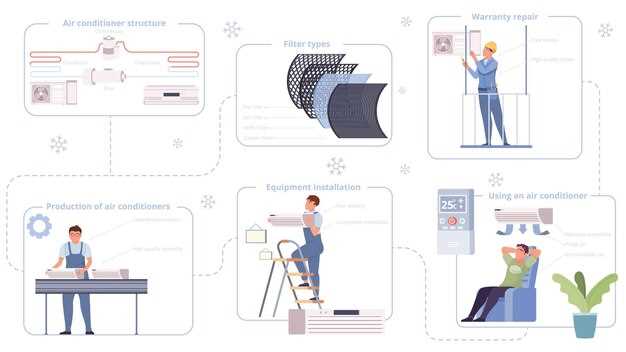The Importance of Proper Airflow Management for Cooling Efficiency


The importance of effective airflow management in any cooling system cannot be overstated. It plays a critical role in enhancing the efficiency and longevity of equipment, ensuring that components operate at their optimal temperature. When airflow is poorly managed, hot spots can develop, leading to overheating and ultimately, system failure. Understanding the principles of airflow management is essential for anyone looking to maintain peak performance in environments such as data centers, server rooms, or industrial settings.
Proper airflow management involves the strategic organization of air circulation paths, which allows for a balanced distribution of cool air while effectively removing warm air. This process starts with the layout of equipment, where the positioning of servers, racks, and cooling units must be carefully considered. Hot aisle/cold aisle configurations are commonly employed to maximize efficiency, directly impacting cooling performance and energy consumption.
Another crucial aspect to consider is the use of physical barriers and containment systems. Containment strategies help prevent the mixing of hot and cold air, ensuring that the cooling resources are directed where they are needed most. Additionally, monitoring systems that track temperature and airflow can provide valuable insights, enabling responsive adjustments to maintain optimal conditions.
Understanding the Role of Airflow in Cooling Systems
Efficient airflow management is essential for the performance of cooling systems in various applications, including data centers, computer hardware, and HVAC systems. Proper airflow ensures that heat generated by equipment is effectively dissipated, maintaining optimal operating temperatures.
Airflow in cooling systems serves several critical functions:
- Heat Dissipation: Air carries heat away from components, preventing overheating and ensuring longevity.
- Temperature Regulation: Consistent airflow helps maintain uniform temperature levels across different system components, promoting efficient operation.
- Energy Efficiency: Effective airflow reduces the workload on cooling units, leading to lower energy consumption and operational costs.
There are key factors that influence airflow in cooling systems:
- Fan Placement: The location and orientation of fans significantly impact airflow patterns. Fans should be strategically placed to create a smooth airflow pathway.
- Air Duct Design: Ducts should be designed to minimize resistance and turbulence, allowing for unimpeded airflow. Proper sizing and layout are essential.
- AIR Filters: Clean filters prevent blockage and ensure optimal airflow. Regular maintenance and replacement are necessary to sustain performance.
- Ambient Conditions: External factors, such as room temperature and humidity, affect cooling efficiency. Adequate ventilation in the environment can enhance performance.
Implementing effective airflow management strategies includes:
- Utilizing computational fluid dynamics (CFD) simulations to optimize airflow paths.
- Incorporating hot aisle/cold aisle configurations to separate hot and cold air streams.
- Regular monitoring of temperature and airflow metrics to identify and address potential issues.
In conclusion, understanding the role of airflow in cooling systems is pivotal for achieving optimal cooling performance. Addressing airflow challenges contributes to the efficiency, reliability, and sustainability of cooling solutions.
Identifying Common Airflow Issues in Your Setup
Effective airflow is crucial for maintaining optimal cooling performance in any setup, whether it’s a data center, server room, or home PC. Identifying airflow issues early can prevent overheating and prolong the lifespan of your equipment. Here are some common problems to look for:
Firstly, check for obstructions in the airflow path. Dust buildup on vents, fans, and heat sinks can significantly impede air circulation. Regular cleaning of these components is essential to ensure unrestricted airflow. Additionally, ensure that cables and other materials are properly routed and not blocking airflow. Tidy cable management not only improves aesthetics but also enhances cooling efficiency.
Secondly, consider the placement of your equipment. Devices should be spaced adequately to allow for airflow between them. Crowding equipment can trap heat and reduce cooling effectiveness. Ensure that your setup is not placed against walls or in corners where air cannot circulate freely. Maintaining an open space around your equipment can facilitate better airflow.
Moreover, verify that your fans are functioning correctly. Check for any signs of malfunction, such as unusual noises or a lack of rotation. Ensure that intake and exhaust fans are installed in the right configuration; typically, intake fans should be positioned to draw cool air in, while exhaust fans should expel warm air out of the system. Improper fan placement can create pressure imbalances, resulting in hot spots within the setup.
Finally, monitor temperature levels regularly. Use temperature sensors or software to track the heat generated and compare it to the ideal operating range for your equipment. If temperatures are consistently high, it may indicate inadequate airflow or a need for more effective cooling solutions, such as additional fans or a liquid cooling system.
By proactively identifying and addressing these common airflow issues, you can significantly enhance the cooling performance of your setup, ensuring that your equipment operates efficiently and lasts longer.
Best Practices for Designing an Airflow Path
Creating an efficient airflow path is essential for optimal cooling performance in various environments, particularly in data centers and server rooms. Following these best practices can significantly improve airflow management and equipment longevity.
Firstly, start with a clear layout. Design the layout of the space to minimize obstructions. Consider using hot aisle and cold aisle containment strategies, which separate incoming cold air from outgoing hot air. This separation helps direct airflow effectively and maintains temperature consistency.
Secondly, optimize the placement of air conditioning units. Position cooling units to maximize air distribution across the server racks. Ensure that the cooling equipment is not blocked by furniture, equipment, or any structural elements that could impede air movement.
Thirdly, utilize airflow management tools. Implement tools such as perforated tiles, blanking panels, and ducting systems to guide airflow. Perforated tiles should be placed in front of racks to provide cold air directly to the intake of servers, while blanking panels can prevent the escape of cold air through unused rack spaces.
Additionally, maintain proper rack density. Ensure that racks are not overloaded, which can lead to hotspots due to uneven air distribution. Balance the number of equipment in each rack to promote effective cooling throughout the entire row of racks.
Furthermore, regularly monitor and adjust the airflow. Use airflow sensors and thermal cameras to identify hotspots and airflow inefficiencies. Regular assessments allow for adjustments in equipment arrangement and airflow management solutions, enhancing cooling performance over time.
Lastly, consider the use of computational fluid dynamics (CFD) simulations during the design phase. CFD modeling can forecast airflow patterns and assist in identifying potential issues before implementation, allowing for a proactive approach to airflow management.
Utilizing Fans and Ventilation for Improved Air Distribution
Proper airflow management is essential for maintaining optimal cooling in data centers, server rooms, and various industrial environments. One of the most effective ways to enhance air distribution is through the strategic use of fans and ventilation systems.
Fans play a crucial role in moving air throughout a space. Their primary function is to create a consistent airflow that can circulate cooling air and expel hot air effectively. There are several types of fans, including axial fans and centrifugal fans, each suited for specific applications. Axial fans are ideal for general ventilation, while centrifugal fans are better for high-pressure systems.
To maximize the benefits of fan usage, it is important to consider their placement. Fans should be positioned to promote a unidirectional airflow, reducing turbulence and ensuring a smooth passage of air. This can involve setting up fans to draw cool air in from designated cold aisles and expelling warm air to designated hot aisles, creating an efficient cooling loop.
In addition to fans, ventilation systems contribute significantly to effective air management. Natural ventilation, aided by strategically placed vents, can enhance airflow without the need for mechanical systems. However, mechanical ventilation, which includes exhaust fans and air handling units, is often necessary in tightly sealed environments. These systems can be adjusted based on temperature and humidity levels, ensuring that air distribution meets the current cooling demands.
Furthermore, incorporating variable speed drives (VSDs) in fan systems can offer an additional layer of efficiency. VSDs adjust fan speeds based on real-time cooling needs, reducing energy consumption while optimizing airflow.
Regular maintenance of fans and ventilation systems is vital to ensure their longevity and effectiveness. Accumulated dust and debris can hinder performance, so establishing a maintenance schedule to clean and inspect these components is recommended.
In conclusion, utilizing fans and ventilation effectively not only improves air distribution but also contributes to overall energy efficiency and cooling performance. By strategically placing fans and maintaining ventilation systems, organizations can achieve a well-cooled environment, prolonging the life of their equipment and reducing operating costs.
Monitoring Temperature and Humidity for Better Performance

Effective cooling performance in data centers and IT environments relies heavily on maintaining optimal temperature and humidity levels. Monitoring these parameters is crucial for ensuring that equipment operates within safe limits, thereby extending its lifespan and enhancing overall efficiency.
Temperature fluctuations can lead to hardware failures. Continuous monitoring helps identify hotspots and cool areas within the environment. By using thermal sensors and infrared cameras, facilities can visualize temperature distributions and make necessary adjustments. Ideal operating temperatures generally range between 18°C to 27°C (64°F to 80°F), but maintaining a consistent airflow throughout the space is equally important to prevent localized overheating.
Humidity levels also play a significant role in performance management. Low humidity can lead to electrostatic discharge (ESD), damaging sensitive components, while high humidity levels can cause condensation, resulting in corrosion and short-circuits. Maintaining relative humidity between 45% and 60% is recommended. Humidity sensors should be strategically placed to provide accurate readings across varying locations within the facility.
Incorporating advanced monitoring systems with real-time alerts allows for proactive management. These systems can automatically adjust environmental controls, such as HVAC settings, to respond to detected changes, ensuring optimal conditions are preserved. Furthermore, data analytics tools can interpret historical temperature and humidity data to predict trends and enable better long-term strategic planning.
Regular assessments and maintenance of monitoring equipment itself are vital. Calibration of sensors ensures accuracy, and periodic testing should be conducted to confirm system integrity. Overall, diligent monitoring of temperature and humidity not only protects valuable IT assets but also enhances energy efficiency, contributing to overall operational reliability and cost savings.
Regular Maintenance: Keeping Airflow Paths Clear
Regular maintenance is crucial for ensuring that airflow paths remain unobstructed and effective in any cooling system. The first step involves routinely inspecting all vents, ducts, and grilles for dust accumulation or physical blockages. This can significantly impede air movement, leading to overheating and inefficient cooling performance.
Cleaning these components should be done at least every three to six months, depending on the environment and usage. Use a vacuum with a hose attachment to remove dust and debris, and consider using a damp cloth for grilles to ensure a thorough cleaning.
In addition to cleaning, it’s important to check for any obstructions near airflow paths. Furniture, equipment, and other items should be strategically positioned to avoid blocking vents. Maintaining a clear space around these areas enhances the system’s overall efficiency.
Routine inspections of insulation and seals around ducts are also necessary. Damage or wear can allow conditioned air to escape, which not only disrupts airflow but also increases energy costs. Replace or repair any compromised insulation promptly to maintain system effectiveness.
Finally, scheduling professional maintenance at least once a year can provide a comprehensive evaluation of your cooling system. Technicians can identify airflow obstructions that may not be visible during regular inspections and perform necessary adjustments to optimize performance.
